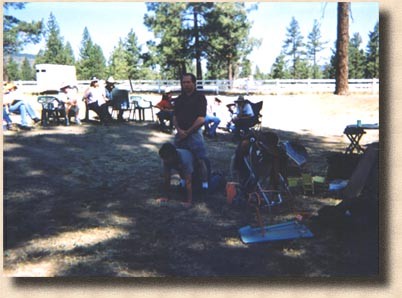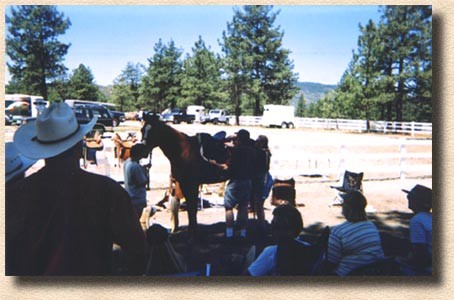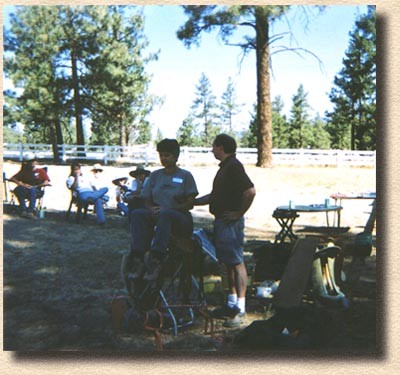













|

Let us judge all saddles on the following criteria:
If those four points are met then the saddle is great. The job of the saddle is to do nothing. It should always be acted upon but should never act upon the horse or rider. If it does nothing it fits, it works.
- Does it form a tunnel over the horses spine?
- Does the rigging hold the saddle quietly in place over the rib cage?
- Does the seat create a level platform for the riders pelvis?
- Does any part of the saddle interfere with the motion of the horse? (aside from the underlying reality that riding does that.)

You will need to understand that width is only one of four elements of the saddle that allow it to work with the shape of the back. You will also need to look at the twist of the panels. This gets the saddle parallel to the back. Then you will need to look at the rock of the saddle, this allows for the up and down undulations of the back. Lastly you will need to look at the flair of the saddle which allows for the movement of the shoulders. When you get that all squared away you will need to look at the rigging and make sure it is not tipping the saddle forward.

When I first began dialogue with David on the principles of saddle fit, I was more afraid of a tree with a fair amount of rocker to it (i.e., one that would contact the horse's ribcage toward the middle of the tree),than I was of a tree that bridges (i.e., one that contacts the withers and loins before it makes contact in the center). And I held this view precisely because of what you were thinking - that, if it was "getting" him in the center already, wouldn't it be even worse if he were to round up?
What emerged from our dialogue, and what I had to learn, was that it is WORSE to bridge than to have even a high amount of rocker. The reason for this is that two factors - flare and rocker - govern whether the animal can move his shoulders and loins comfortably and freely when saddled. If the saddle is gouging the horse either in the withers or the loins, his reaction will be to clamp and tighten his back muscles, and thus to hollow his back.
The exercise David suggested to you in the above post, about having someone get on your back and see where you felt greater lightness - with your back rounded or with your back hollow - does not relate so much to weight on your BACK as to the weight on your FORELIMBS. When you round up, even if you don't rock your body backwards at all, you will find that the cantilevering action of your tucking your fanny, coiling your loins, and raising your back "magically" draws weight off of your forelimbs and transfers it to your hind limbs.
When you saddle a horse with something that "gets" him in the shoulders or loins, he becomes very reluctant, or even unable, to coil his loins and cantilever himself into lightness. And it's a vicious cycle too - the more the saddle gouges him in these places, the more he'll hollow his back to protect himself, and the more that will throw him onto the forehand. The more he throws himself onto the forehand, dropping rather than raising the base of his neck, the more the saddle will gouge him...and on and on.
It is only when we saddle the animal with something that CANNOT pinch or gouge him in either the shoulders or loins that he will round up. An ideal fit would call for just the minimum amount of rocker to achieve freedom in shoulders and loins in all gaits, paces, transitions, and movements, whether forward, backward, oblique, airborne, lateral, or twisting. And the fact that David builds more flare into both the front and back parts of his saddles, is the other important factor that allows him to fit the horse with the minimum, and not an excessive, amount of rocker.
So, exactly as both of you have discussed, getting the right amount of rocker is important and having nice, wide bars that carry the weight out to the sides of the ribs is important, too - that you not bounce or jab more than you're going to have to anyway.
And this is the last point, and why I've entitled my post the way I did up there. Horses don't "just" move AWAY from pressure...what they really, really like is to move TOWARD comfort. This is why Mark's mustang really laid down. Because what does the teaching that the horse received from his handlers actually come to - from HIS point of view? No horse ever actually learns "just" to escape. So to teach one at all, you have to teach him that AFTER he moves THEN there will be release and relief from pressure. This is what works because this is the very nature of the horse species. When the train comes through Squire Green's field in "Black Beauty," the horses snort and run, but they don't run TOWARD the train for sure. They ALSO don't run "just anywhere." They run in a direct line, as near as they can manage, AWAY from the train, and they run NO FARTHER than they have to, to achieve sufficient comfort that their inner emotional barometer switches over from fear to curiosity. 'Nother words, even if they weren't fenced in, they would have STOPPED running someplace - and then - you know what they do - they stop and turn around and look. This is the point where they have achieved "sufficient" comfort.
So you can think of your horse's back as a glob of silvery mercury. It runs AWAY from where the pinch is, but at the same time, it will run TOWARD the place that is farthest from the pinch - even if, in that place, there is still some degree of pressure that would never have been there if the animal had not been mounted.
There are some horses, and I have ridden 'em, that learn to round up BECAUSE their saddle pinches in either the shoulders or over the loins or both. But I wouldn't want to take a chance on this! It surely isn't reliable or efficient! And - this system will ONLY work IF the amount of rocker in the saddle that pinches is ENOUGH so that, when the animal does round up, he "finds" the center of the tree and thus is even able to lift the pinching corners off of contact with his body through the act of rounding up.
So, let's saddle him David's way - much better for all parties! So you give your horse the best deal possible - that's the idea. You ride well, you saddle him the best you know how and the best you can afford. That's the way!

|
| ||
|
| ||
|
|